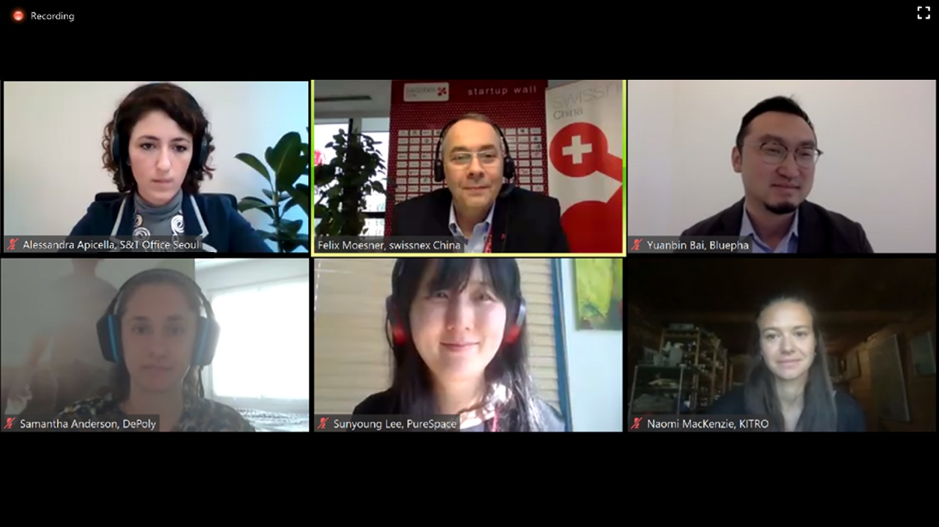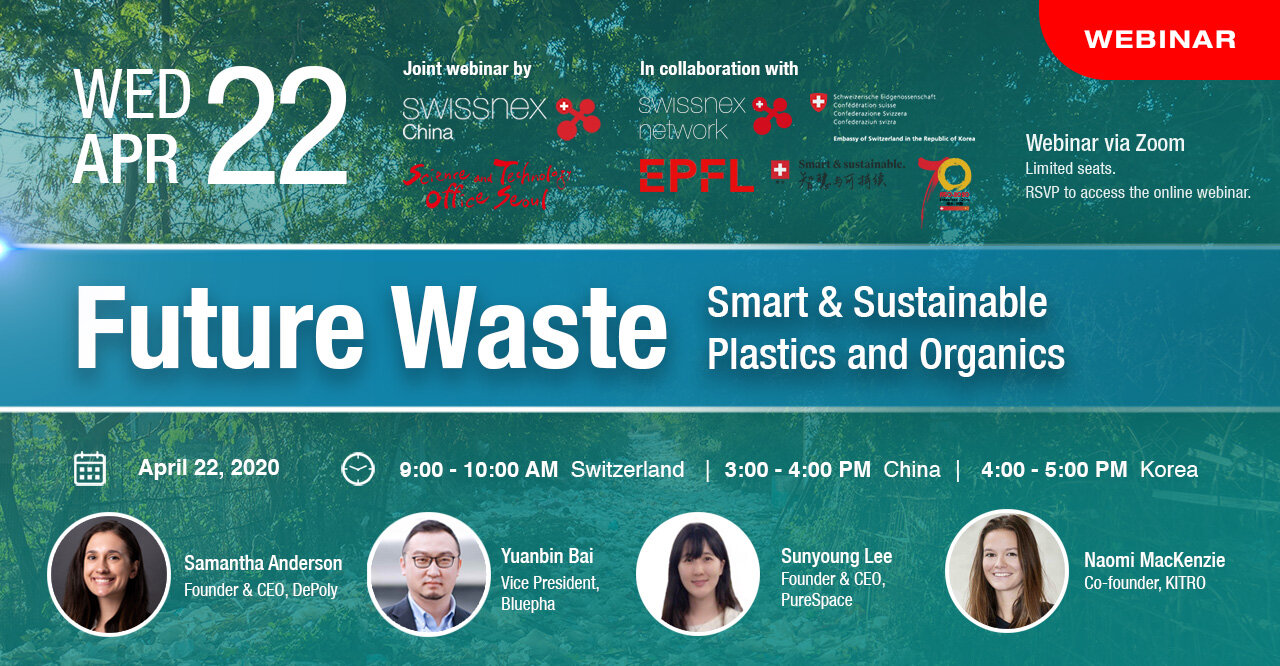By Suyao Ao, PR & Communications Coordinator
On April 22, 2020, we were joined by 158 live attendees to learn about how startups from China, South Korea and Switzerland are pioneering in turning today’s plastic waste and organic waste into a resource for tomorrow, contributing to the creation of a circular economy. We were pleased to have experts in their fields: Samantha Anderson, Founder & CEO at DePoly; Yuanbin Bai, Vice President at Bluepha; Sunyoung Lee, Founder & CEO at PureSpaces; Naomi MacKenzie, Co-founder at KITRO. During the Q&A session after the presentations, we received 38 questions centering around impact on environment, mask recycling, negative oil price, speed of biodegrading, target types of food, competitors, public awareness and much more.
Gallery view of the speakers
This is the first joint webinar within the swissnex Network between China, South Korea and Switzerland. The webinar is co-organized by swissnex China and the Science & Technology Office Seoul in collaboration with swissnex Network, Embassy of Switzerland in Republic of Korea, and EPFL (École polytechnique fédérale de Lausanne).
______
Here are some key takeaways we would like to share with you from each speaker:
“A Sustainable Circular Economy for PET Plastic” by Samantha Anderson, Founder & CEO at DePoly
It is believed that most PET is recycled. In reality, only 9% of the PET plastic we produce is recycled and much of the PET plastic ends up in the oceans or landfills. The current recycling system is a costly linear economy, which includes collection, size sorting, manual sorting, float sorting, grinding, washing, drying, melting, screening, filtering, pellesting. With this system, PET can only be recycled a couple of times, and it requires manual sorting and is energy intensive. Moreover, not all feedstock can be recycled. It can only recyle clean plastic bottles, but not mixed plastics such as shoes, fibres and fabrics etc.
However, chemical recycling fits into the circular economy very well. Among the major methods of chemical recycling, DePoly uses Hydrolysis which extracts terephthalic acid (TPA) and ethylene glycol (EG), which are main components of PET plastic. It operates at standard temperature and pressure, uses sustainable chemicals, lowers the energy bill by 66%, reduces CO2, and can process all PET waste (dirty, mixed plastics, fabrics, etc.).
DePoly can buy PET at higher market price from waste management organizations, or fabric companies etc., and sell TPA and EG to the industry, such as companies that make PET or suppliers of TPA and EG to chemical labs. With this technology, DePoly can contribute to tackling the economical and social challenges faced by their suppliers and customers.
Currently, DePoly is operating in the Swiss market for demonstration and entry of market, and it plans to expand to other markets, especially the Asian market which dominates both the PET plastic and TPA market.
“Biodegradable Polymer as a Solution to Plastic Waste Issues” by Yuanbin Bai, Vice President, Bluepha
In order tackle the issue of plastics waste, BluePha offers another alternative called PHA, a material with a long history in nature with plastics-like property.
PHA (Polyhydroxyalkanoates) is a kind of Polyester from nature by microorganisms, which is is produced with Glucose or Lipids as the feedstock. It is bio-based and biodegradable, and includes various types such as PHB / PHBV / PHBH / P34HB. The first example of PHA to be isolated and characterized was PHB in the year 1926 by Maurice Lemoigne.
By comparing the processes of the conventional plastics and PHA, we can see that the entire lifecycle of PHA is a green cycle. The major steps of PHA manufacturing consist of processing bio-based raw material, fermentation, extraction, purification and products made with PHA are naturally degradable in soil or water when discarded, turning into nutrition for microorganisms.
PHA can partly substitue any of the conventional fossile-based plastics. The typical applications of PHA includes injection molding, extrusion, thermoforming, non-woven fabrics, fibres, 3D printing, paper, fertilizer coating, glues, adhesive and etc.
With 161 million plastics produced in packaging and 65 million in textiles in 2015, if only 1% of the plastics in packaging and textile would be replaced by PHA, its market size could approximately reach €10 billion.
“Decomposing ethylene and microorganisms to reduce food waste” by Sunyoung Lee, Founder & CEO, PureSpace
According to predication by the United Nations, 60% more food will be needed until 2050, to meet the demand of 10.5 billion population. 1/3 of post harvest food are lost along the entire supply chain, among which fruit & vegetables food losses of 45% are the most significant.
Major causes of freshness reduction is due to respiratory activity, ethylene, and mold. Respiratory activity is typically reduced through cold chain. But not much is done to ethylene and mold.
What PureSpace does is to effectively decompose ethylene and microorganisms to extend shelf life and reduce food waste. According to control experiments, we can see that by reducing ethylene from 109ppb to 13ppb, the food loss rate can be reduced from 30% to 10%.
With PureSpace products, it’s possible to significantly reduce ethylene from the air where fruits and vegetables are stored. It’s safe on consumers as it does not treat any coatings directly on food. PureSpace products can be place in cold storages, warehouses, packing houses, retail storages, and reefer trucks etc.
“The benefits of measuring and monitoring your resources” by Naomi MacKenzie, Co-founder, KITRO
Trational ways of monitoring food waste always requires manual entry, which incurs high costs, time investment, and lacks overview. As a result, the problem of food waste is mostly ignored. However, in order to set goals for reducing environmental impact, it is very important to continuously measure and be aware of the quantity of waste we’re producing.
What KITRO offers is the first fully automated food waste solution with an IoT device and camera over the trash can. The device can give a complete overview on the weight, cost, ingredients and sources of food waste, which can help the management of commercial kitchen make data-driven decisions to optimize workflow, save cost, and reduce evniromental impact. In the meantime, operational changes to reduce food waste also requires an increased awareness among the consumers.
In the end, we would like to express our special appreciation to our speakers for their presentation and interesting discussions during the Q&A session. We would also like to thank Science & Technology Office Seoul for the collaboration.
For details of our previous and upcoming webinars, please click here. We look forward to seeing you again! If you have any questions or suggestions, please contact us at info@swissnexchina.org.
You can find below links to the webinar recordings:








